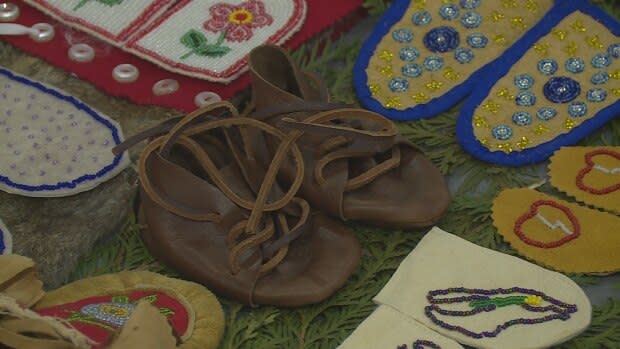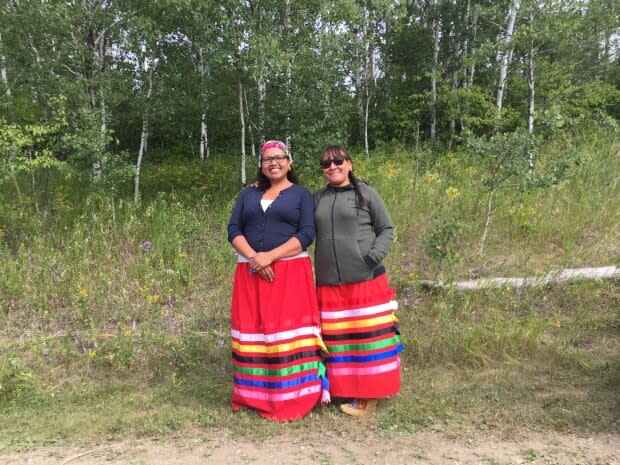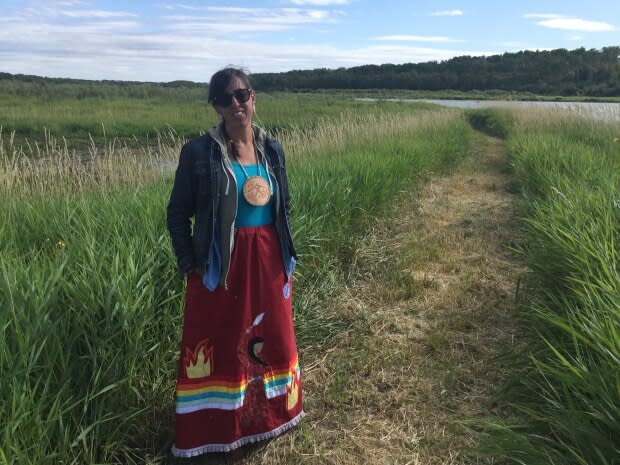Walking With Our Sisters collective member reflects on exhibit's meaning
What began as a call out on social media in 2013 for moccasin vamps culminated in 1725 pairs and exhibits in 27 communities from coast to coast.
Autumn EagleSpeaker, originally from Kianai Nation, Alta, has been a part of Walking With Our Sisters since 2014 when the exhibit travelled through Calgary.
Walking With Our Sisters was a travelling exhibit that used vamps, the beaded tops of moccasin also known as tongues or uppers, to bring awareness to missing and murdered Indigenous women and girls.
"We're bringing over the prayers for the many different loved ones that have been lost, for their sisters, for our aunties and our relatives," said EagleSpeaker.
EagleSpeaker and friend Kelly Morning Bull are are part of a Calgary collective that helped facilitate the tour. On Sunday, the pair travelled to Batoche, Sask., for the culmination of the exhibit's closing ceremony.
For EagleSpeaker, the exhibit's seven-year tour represents the healing journey for those families who have lost loved ones. She said it also was a part of her own healing process, as she was recently diagnosed with cancer.
"It was kind of a big journey to do before I go through my surgery process. I've been doing a lot of traditional healing, but being here is just another level of that," she said.
We are glad to be able to hold that space for them so they can go through that process of letting go. -Leanna Marshall, National Collective Walking With Our Sisters
EagleSpeaker said they made the trip to honour the many women from Calgary who couldn't attend along with two of her relatives.

One of EagleSpeaker's aunts was murdered in Seattle, Wash., and a cousin died in 1969 in an unsolved murder case.
"My mom and aunties have carried that pain for a really long time, since the '60s. It was before my time, but, we as a family, it is part of our legacy now."
National tour
Last week's ceremony was the first time the exhibit was outdoors, covering hundreds of yards from camp to river.
Each pair of vamps represented one of the lives lost. Some were intentionally unfinished to represent lives cut tshort.
The last stop was located on the Batoche historic site, in the same spot the women's camp was during the Battle of Batoche in 1885. A trail of the red cloth sat on an old cart trail that led down to the South Saskatchewan River.

"This is a beautiful thing — Walking with Our Sisters is — because it's all led by ceremony and it comes from the grandmother lodge," said Leanna Marshall, a representative of the national collective, originally from the Big Trout Lake in northern Ontario.
"We are glad to be able to hold that space for them so they can go through that process of letting go."
The 1,700 plus vamps are either being returned to the 1,300 artists across Canada or burned in a sacred fire as part of a releasing process.
Going Forward
EagleSpeaker said the closing ceremony wasn't the end for her or for hundreds of families across Canada.
She said that, since becoming a mother, the meaning of staying safe has taken on a deeper meaning.

Although the Walking With Our Sisters art exhibit has now come to a close, EagleSpeaker said the women involved have created a contrywide sisterhood.
"I am making sure my children are involved in activism and are aware of missing and murdered Indigenous women and girls in the country," EagleSpeaker said.
"Are you?"


